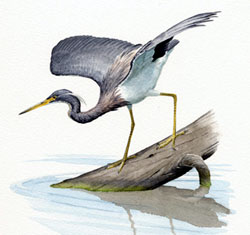Breeding Bird Atlases (BBA)
Find a Bird - BBA1
Breeding Bird Atlas 1 Species Accounts
Tricolored Heron
Egretta tricolor
Egg Dates
not available
Number of Broods
one

For reasons as yet unexplained, there was a marked influx of southern herons and related species into Massachusetts in the early 1970s. Many of these birds established mixed breeding colonies, most notably at Clark’s Island in Plymouth and House Island in Manchester. The Tricolored Heron, formerly known as the Louisiana Heron, was part of this invasion.
The first generally accepted appearance of the Tricolored Heron in the state occurred in 1940 at Ipswich. Since then, reports have increased, and the species has occurred annually since 1960. It is usually restricted to the coast, although there are a few recent records of late summer occurrences in the Connecticut River valley. Breeding was suspected first in the early 1970s, when Tricolored Herons were observed flying in to roost in the evening with other herons at Clark’s Island. However, studies of the Clark’s Island heronry produced no evidence that tricolors were nesting. Not until 1976 was breeding confirmed in the state, when 3 pairs, each with two young, were located in July on House Island. The young were well feathered but still showed traces of down, especially on the head, and were not yet capable of sustained flight. Breeding has not been recorded in the state since the herons abandoned House Island about 1980.
Most years Tricolored Herons return by late April, but some individuals may appear several weeks earlier. They search for fish, amphibians, crustaceans, gastropods, and insects in marshes, swamps, mudflats, and tidal creeks. Foraging is done in shallow water, where the birds may wade slowly, stand, or run actively in pursuit of prey.
Tricoloreds usually nest in mixed-species heronries. Males choose and defend a nest site and advertise for mates with a series of highly ritualized displays. An “upright display” is used during aggressive encounters, accompanied by low aah calls. In “forward display,” the plumes are raised. “Circle flight” and “stretch-snap display” (Palmer 1962) are also part of the behavioral repertoire. When meeting at the nest, the members of a pair greet one another with calls and crest raising.
The nest, a platform of sticks 9.5 to 12 inches wide, is lined with twigs and leaves. The usual clutch is three to four greenish blue eggs. Both parents incubate and care for the young. Hatching occurs after about 21 days, and the juveniles are fed by regurgitation. They can climb when they are three weeks old and fledge in another two weeks.
In New York, a nest containing three eggs was discovered 10 feet up in a Gray Birch on May 17. A second nest was located 4 feet high in a Gray Birch and a third 3.5 feet up in Bayberry. Four nestlings were observed on July 19, and a nestling, believed to be about two weeks old, was located on August 4 (Bull 1974). It is impossible to construct a complete set of nesting data for Massachusetts from a single breeding record, but it seems likely that this species would follow a chronology similar to that of the Little Blue Heron.
Unlike most heron species, tricolors do not engage in widespread postbreeding dispersal. Thus, the appearance of birds in late summer roosts, especially at Plum Island, would seem to suggest the possibility of continued local breeding but might also represent migrants that have bred on offshore Maine islands. Tricolored Herons generally have departed our area by the end of September, but there are records extending to early December. Most individuals winter from Florida southward.
Map Legend and Data Summary
Atlas 1 data collected from 1975-1979


Note: rare; bred twice at House Island, Manchester; no recent increase noted
Richard A. Forster and W. Roger Meservey



